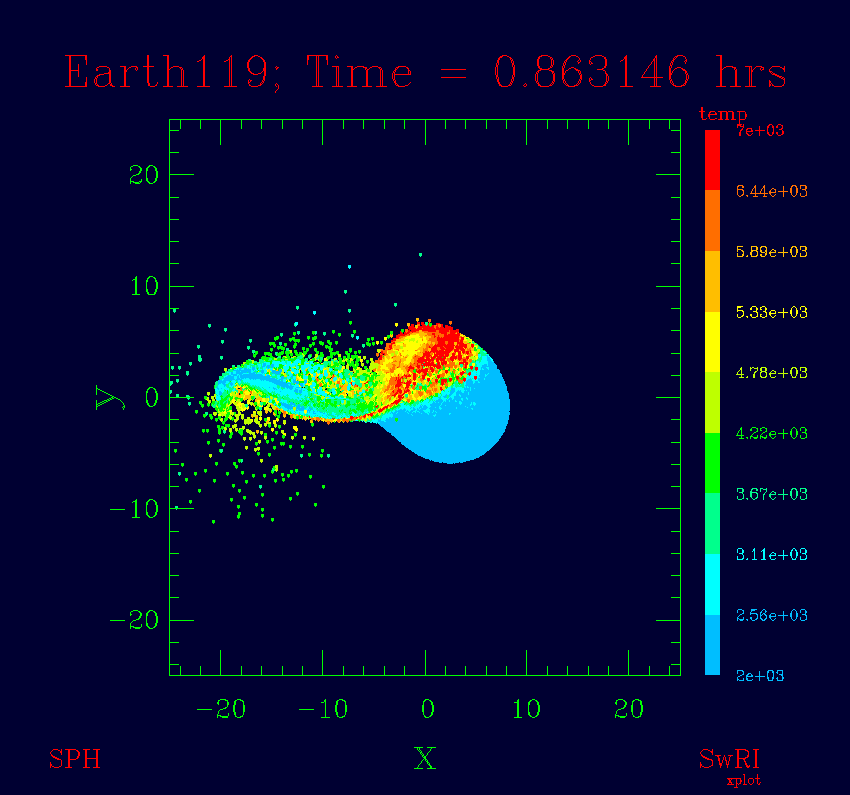About five billion years ago the world was without form, and void. But a bunch of interstellar debris (left over from the supernova explosions of earlier stars) had coalesced to form a central clump and a surrounding disk of dust. At least this is the current theory.
Gradually the central clump got big enough, by attracting a lot of the debris by gravity, that temperatures and pressures inside led to fusion reactions between hydrogen atoms. It began to emit a lot of energy in the form of electromagnetic radiation. We now call it "The Sun".
Meanwhile the dust in the spinning disk around the Sun began to clump up. One of those clumps was to become our Earth. About 4.7 billion years ago it was a hot ball of rock, being bombarded by thousands of meteors and asteroids all the time as the smaller bits of the developing solar system collided with Earth. The energy of these impacts was enough to keep Earth nearly molten, perhaps with a crispy crust.
What About The Moon?
The leading current theory is that a huge ball of rock about the size of Mars struck Earth a glancing blow. The impact melted both planets, and a huge plume of molten rock spewed off and began orbiting the single remaining planet. Gradually this splash of rock condensed to form the Moon.
 Computer Simulation After Impact
Computer Simulation After ImpactThis "giant impact" theory is supported by recent research with computer models that show that such an impact could form a moon in the correct orbit and with the correct composition. The orbit of the Moon, the rotation of the Earth, and the composition of the Moon are constraints that any such model must explain.
Researchers at Southwest Research Institute and the University of California at Santa Cruz showed that such an impact, blasting off surface rock from the Earth, could result in the iron-poor composition of the moon. The Earth has an iron-rich core, formed early in its history when heavier iron sank toward the center of the planet. The Moon seems to be made of lighter rocks nearly all the way through, similar in composition to those in the outer layers of the Earth.
Stargazers among you will have noticed that the plane of the Moon's orbit is not in the plane of the Earth's orbit around the Sun, the plane of the planets. The Sun and the planets stay in this plane, called the ecliptic, which passes through the signs of the zodiac. The solar system is flat.
But the plane of the Moon's orbit is tilted by about 5% from the plane of the ecliptic. (If the Moon's orbit was in the same plane as the Sun's, we would have eclipses every day. As it is the Moon gets between the Sun and Earth (or vice versa) only once in a while, when its orbit crosses the plane of the ecliptic just when the Sun and Earth are lined up with it.)
This tilt of the Moon's orbit can be explained by the giant impact theory. An impact at the right angle, an object of the right mass, and other factors falling in the right range gives the orbits we observe.
Continued Bombardment of Earth and Moon
Both the Earth and the Moon continued to be struck by asteroid-sized rocks, with a major peak of bombardment 3.9 million years ago. This is known from analysis of the ages of meteorites that were once part of the moon and were blasted off at that time. Analysis of the pattern of cratering on the Moon supports this result.
Early Origin Of Life
After 3.9 billion years ago the bombardment tapered off rapidly. The surface of the Earth cooled and enough water collected for life to leave traces about 3.7 billion years ago. The fact that life appeared so soon after conditions permitting it developed on Earth suggests that the origin of life is "easy". Of course, the most complex living organisms on Earth were like bacteria until about 1.2 billion years ago. Prokaryotes like bacteria had Earth to themselves for 70% of history of life on "our" planet.
Kinda makes you think, doesn't it?
For More Information:
Some of the animations generated by the SwRI/UCSC computer analysis can be downloaded here.
Links to images and movies at SwRI
Some of the research results are available on line, for example here. (Canup, R. M. 2003. Simulations of a late lunar-forming impact . Icarus, 2004 )
Press release from Southwest Research Institute.
Overview of facts about Moon
Nice U. Hawaii site discussing origin of the Moon
Space Daily item about lunar cratering research
Technorati tags:
science
astronomy

No comments:
Post a Comment